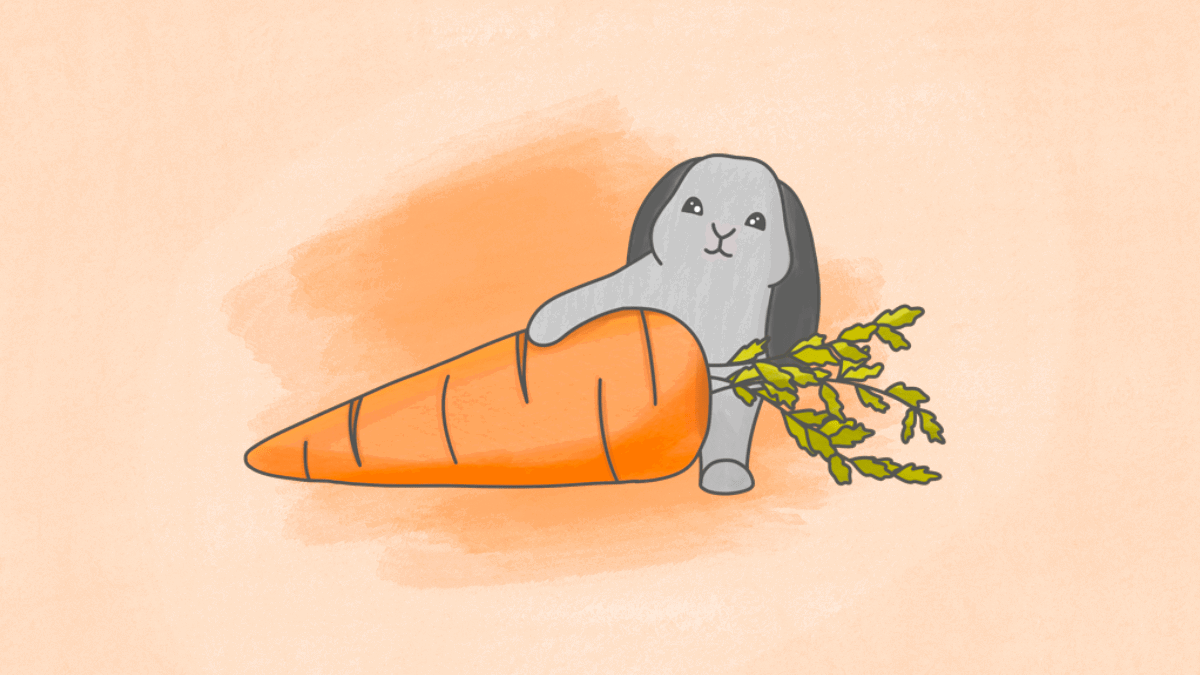Savoirs
Carrots for Rabbits

Carrots in practice for rabbits
Can one think of the rabbit without thinking, almost immediately, of the carrot? Lulled since our childhood by many anthropomorphic characters with long ears that never separate themselves from this vegetable, they have ended up becoming, in spite of themselves, inseparable.
Yet the carrot should not be considered a vegetable, but rather a treat. Indeed, its root is caloric and rich in sugars, and should therefore be given only infrequently (2 to 3 times a week) and in small quantities (1 slice).
However, there is no need to demonize it: if its root is, as we have seen, rather to be considered as a treat and to be used as a fruit rather than a vegetable, its aerial parts (“tops”) are perfectly adapted to our little companions: rich in fiber, calcium, iron, beta-carotene and vitamins B and C, they are low in calories and contribute to a good wear of the teeth.
Learn more about the complete composition of carrots here
Origin of the Carrot
The wild carrot has its origin in Afghanistan. However, this vegetable, is far from the one we know today: its root is thin, its skin is thick, leathery, its core is fibrous and its color varies between red and purple.
In ancient times, it was cultivated less for its root than for its tops, which were thought to have medicinal properties and were used as an aromatic herb. The root was mainly used to feed livestock.
During the Middle Ages, and in spite of the defects mentioned above, it was a very consumed vegetable, because of its ease of culture. At that time, we could find white, yellow, red or purple carrots… But not orange one.
The Dutch succeeded in creating it in the XVIth century, by crossing a yellow variety and a red variety, in order to prove their affection to the house of Orange. But its color was not its only characteristic: these gentlemen have created the first variety of fleshy carrot, managing to get rid of this too fibrous heart and this scrawny root; which explains of course the speed with which this variety have spread in all Europe.
Today we find varieties of all sizes and many colors, each one having its small particularity. But is it really for this that we consume so much of it? Because, at the moment, 1 vegetable out of 5 consumed is a carrot, which makes it the second most consumed vegetable by the French, just after… the tomato (which, admittedly, is a fruit, but consumed as a vegetable… Anyway 😊)!
Preserving carrots for your rabbit
It is advisable to separate the tops, which need water, heat and light, from the root, which is a tuber that prefers shade and does not tolerate heat.
Once cut, the tops can only be kept for 2 to 3 days. To maximize their lifespan, don’t hesitate to dip their ends in a glass containing a little water, like a bouquet (nice, eh, for your next Valentine’s Day! 😁)
A little tip: after removing the tops, cut the root of your carrot (topside) at least 2 centimeters away from them, and place this little bit in a transparent container, with a little water (about 1 cm; be careful not to go past the collet, i.e. the junction between the tops and the root), then cover the whole thing with a lid or a little stretch film. Change the water every 2-3 days, and watch with pleasure as new tops grow to replace the old ones! (N.B. this is a process that still takes 2-3 weeks, so don’t be in too much of a hurry 😉 )
For the rest of the root, keep it cool and away from light, in a slightly dampened cloth bag or paper towel, in the crisper of your refrigerator. It will keep for up to 10 days.
Another solution is to peel them, then cut them into sticks or slices (depending on your needs). Then place them in a glass jar, add water until they are completely covered, and place them in the refrigerator.
If you are lucky enough to have a cellar, you can also store your carrots “the old-fashioned way”; but becareful, the tip given above will not apply to you, as you will have to store your carrots without cutting the root. Store the roots in a crate filled with slightly damp sand (garden center sand, not beach sand 😉 ). They will keep this way for up to a few months.
Growing carrots for your rabbit
If you’re tired of running to the stores, you should know that it’s very easy to grow carrots in a pot (or in your garden). All you’ll need is a pot or planter with a drainage hole for water and about 25 cm deep (or your garden soil, you guessed it 😀 ), some potting soil and seeds (carrot seeds, obviously).
Put the potting soil in the pot, water, let the excess water drain away, then sow the carrot seeds. As carrot seeds are small and volatile, you may find it difficult to dose them properly: that’s okay!
Cover with a tiny bit of potting soil (ideally, sift it through a sieve to get the finest possible potting soil over your seeds), water again, but this time with a sprayer or fogger (so as not to “disturb” the seeds).
When you see the first leaves appear, it will be time to thin out: pull out the smallest leaves to leave only one plant every 5 centimeters or so. That’s it!
From now on, all you have to do is water regularly and watch your carrots grow. To vary the pleasures, don’t hesitate to let your rabbit crunch a few tops right in the pot: you’ll see, they are devoted landscapers who prune without tearing up!
Finally, several weeks after sowing, it’s time to harvest: gently loosen the soil around the top of the root to make sure it’s big enough, and if it’s big enough, pull! And here it is, a beautiful carrot!
Recipe with carrots for humans
We could have given you a recipe with the root, but now that we’ve told you so much about the tops, we might as well cook them, right? 😊
Carrot top pesto
Ingredients: about 100g carrot tops, 30g parmesan cheese, 15 cl olive oil, 15 cl water, 15g pine nuts or almonds, 1 clove garlic.
Start by roasting the oilseeds (pine nuts or almonds, depending on your preference), by frying them for a few minutes without fat in a hot pan. Set aside.
If you have trouble digesting garlic or if you find raw garlic too strong in the mouth, don’t hesitate to cook the clove in the oven, without peeling it, at 180°C for about 20 minutes. Once cooked, you can simply press the clove to recover its flesh, which will have lost its spiciness, but not its delicious taste!
In a blender or chopper, place the leaves, garlic, oilseeds and parmesan cheese. Start blending and slowly add the olive oil. Once this is done, slowly add the water until you reach the desired consistency.
And that’s it! Enjoy this pesto on toast or with pasta. A treat!
Carrots seasonality
The peak season for carrots runs from July to October.
However, it is possible to find the so-called strawed carrots from October to March; these are carrots that are “picked” and then redeposited in the fields, before being covered with soil or straw to be protected from the cold, thus allowing them to be preserved and sold in the fall and winter.
Translated from French by Margaux

 Food
Food Essentials
Essentials Toys
Toys Accessories
Accessories Goodies
Goodies

